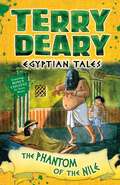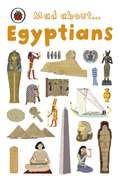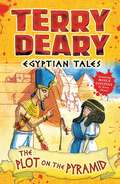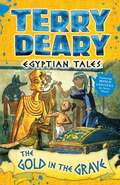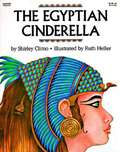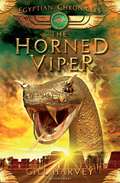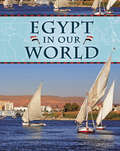Special Collections
Excellent Egyptians
Description: Accessible images and books for special topics
- Table View
- List View
Egyptian Tales
by Terry DearyFrom the bestselling author of Horrible Histories...Menes is training as a scribe in the local temple, and to earn extra money to help his poor family, he agrees to assist rich old Maiarch. Menes must write a prayer to rid Maiarch of an old family ghost. But what if the ghost is actually more human than supernatural? It will take all of Menes's skill and ingenuity to find out the truth...Terry Deary's Egyptian Tales explore the world of Ancient Egypt through the eyes of children who could have lived at the time. These stories feature real people and take place in some of the most recognisable Egyptian settings. This new edition features notes for the reader to help extend learning and exploration of the historical period.
Egyptian citizens (UEB contracted)
by RnibIn this image showing Egyptian citizens, there is a man at the left of the page and a woman at the right. Both are standing and facing forwards so that all their facial features can be seen. A locator dot and title are shown. These must always be at the top left of the page when the image is the right way up. In the top left is the man's head, and he is smiling. He is wearing a simple headdress composed of a piece of cloth held in place by a band. Down the page are his bare shoulders and chest and he holds his arms out to the sides of his body. Around his waist he wears a simple linen loin cloth tied in place by a sash. Down from this are the man's bare legs and feet.The woman's head is at the top right. She also has a smiling face, and her long hair is held in place by a simple hair band. Around her shoulders she wears a large jewelled collar. Her bare arms are held out to the sides of her body, and she wears a bracelet on each wrist. Her full length linen dress reaches down to her ankles at the bottom of the page, and she wears plain leather sandals on her feet.
Egyptian hieroglyphs (large print)
by RnibThis is a multi page image set on two pages with nine hieroglyphs on each page. A locator dot and title are shown on both pages. These must always be at the top left of the page when the image is the right way up. Nine Egyptian hieroglyphs. Nine Egyptian hieroglyphs are shown on this page. They are arranged in three columns of three images. Each hieroglyph has a label above or to its right, showing what is depicted in the symbol, and what letter or letters it represents. At the top left is a forearm representing "a". The hand is to the left and elbow to the right, with part of the upper arm shown above it. Down from this is the foot which represents ""b"". It is a side view with the toes to the left and the heel to the right. Part of the lower leg is shown going up the page from the heel. At the bottom left there is a tethered rope symbol representing "ch". It shows a rope which folds on the right and has two loops on the left. At the top centre of the page is the hand symbol which represents "d". This shows a hand with the wrist to the right and the straight thumb and fingers to the left. Down from the hand is the vulture symbol which symbolises "e". This is a side view of a vulture which faces to the left. One of its eyes can be found along with a curved beak. Its body is partially covered by a folded wing, and both legs are shown. Its tail droops towards the bottom right of the image. At the bottom centre is the pot stand symbol representing "g". This is a side view with a line across the top and bottom of the shape, and a triangular opening in the bottom centre. In the top right corner is a rope symbol which represents "h". The ends of the rope are at the bottom of the symbol. The rope is loosely twisted around itself, ending in a loop at the top. Down from the rope is the shelter symbol also representing "h". It is like a simple floor plan with the entrance in the bottom left of the symbol and the walls shown as a thick line. At the bottom right of the page is the reed leaf symbol which represents "i". The stem at the bottom of the symbol leads up to the blade-shaped leaf. Another nine Egyptian hieroglyphs. This page depicts nine more Egyptian hieroglyphs in three columns of three images. Each hieroglyph has a label above or to its right showing what is depicted in the symbol, and what letter or letters it represents. At the top left of the page is the cobra symbol representing "j". The snake is viewed from the side, with its head at the top left, and long body curving down and right. Down from this is the basket symbol representing "k". The basket is seen from the side, with four layers showing which get wider towards the top. A handle extends out to the right from the top layer. At the bottom left is the water symbol representing "n". It is a thick zigzag line. At the top centre of the page is the stool symbol representing "p". It is a view from above, looking down onto the stripe-patterned seat. Down from this is the folded cloth symbol representing "s". It is a simple vertical line which curves back on itself at the top. At the bottom centre is the bread loaf symbol which represents "t". The loaf is represented by a simple semi-circle. In the top right corner is the sieve symbol representing "th". It is an open circle with horizontal lines. Down from this is the cow's belly symbol representing "th". It has an oval at the right which is joined to a circle with six spikes at its left. At the bottom right is the door bolt symbol representing "z". It is a long thin horizontal shape with two short vertical lines crossing it towards the middle.
Egyptian hieroglyphs (UEB Uncontracted)
byThis is a multi page image set on two pages with nine hieroglyphs on each page. A locator dot and title are shown on both pages. These must always be at the top left of the page when the image is the right way up. Nine Egyptian hieroglyph: Nine Egyptian hieroglyphs are shown on this page. They are arranged in three columns of three images. Each hieroglyph has a label above or to its right, showing what is depicted in the symbol, and what letter or letters it represents. At the top left is a forearm representing a. The hand is to the left and elbow to the right, with part of the upper arm shown above it. Down from this is the foot which represents b. It is a side view with the toes to the left and the heel to the right. Part of the lower leg is shown going up the page from the heel. At the bottom left there is a tethered rope symbol representing ch. It shows a rope which folds on the right and has two loops on the left. At the top centre of the page is the hand symbol which represents d. This shows a hand with the wrist to the right and the straight thumb and fingers to the left. Down from the hand is the vulture symbol which symbolises e. This is a side view of a vulture which faces to the left. One of its eyes can be found along with a curved beak. Its body is partially covered by a folded wing, and both legs are shown. Its tail droops towards the bottom right of the image. At the bottom centre is the pot stand symbol representing g. This is a side view with a line across the top and bottom of the shape, and a triangular opening in the bottom centre. In the top right corner is a rope symbol which represents h. The ends of the rope are at the bottom of the symbol. The rope is loosely twisted around itself, ending in a loop at the top. Down from the rope is the shelter symbol also representing h. It is like a simple floor plan with the entrance in the bottom left of the symbol and the walls shown as a thick line. At the bottom right of the page is the reed leaf symbol which represents i. The stem at the bottom of the symbol leads up to the blade-shaped leaf. Another nine Egyptian hieroglyphs: This page depicts nine more Egyptian hieroglyphs in three columns of three images. Each hieroglyph has a label above or to its right showing what is depicted in the symbol, and what letter or letters it represents. At the top left of the page is the cobra symbol representing j. The snake is viewed from the side, with its head at the top left, and long body curving down and right. Down from this is the basket symbol representing k. The basket is seen from the side, with four layers showing which get wider towards the top. A handle extends out to the right from the top layer. At the bottom left is the water symbol representing n. It is a thick zigzag line. At the top centre of the page is the stool symbol representing p. It is a view from above, looking down onto the stripe-patterned seat. Down from this is the folded cloth symbol representing s. It is a simple vertical line which curves back on itself at the top. At the bottom centre is the bread loaf symbol which represents t. The loaf is represented by a simple semi-circle. In the top right corner is the sieve symbol representing th. It is an open circle with horizontal lines. Down from this is the cow's belly symbol representing th. It has an oval at the right which is joined to a circle with six spikes at its left. At the bottom right is the door bolt symbol representing z. It is a long thin horizontal shape with two short vertical lines crossing it towards the middle.
Egyptian dwarf god Bes (large print)
by Rnib BookshareThis is an image of the god Bes known as the protector of childbirth and children. There is a locator dot shown, which will be at the top left of the page when the image is the right way up. He is standing facing forward so all of his face and limbs can be seen. At the top centre of the page is Bes's tall hat with lines running vertically down it. Down the page from this are his eyebrows, two eyes, nose, mouth and beard. His very large ears stick out to either side of his large head. He does not have any neck so that his arms, held outwards with two bracelets on each, appear to grow out of his head. On his chest, he wears an Ankh symbol, thought to represent eternal life and life after death. It is hanging on a necklace, which is not shown. Further down the page are Bes's naval, a loincloth and his two short legs.
Mad About Egyptians
by Ladybird BooksAre you mad about Egyptians? From masks and mummies to pharoahs and pyramids, this book is perfect for all ancient Egypt enthusiasts. Ladybird's Mad About series is all about giving its readers all the facts they could possibly need about their favourite subjects. Get ready to impress all your friends with all your new knowledge!
Egyptian Gallery
by RnibOrigin unknown; 395-30 BC; mummified cat in linen bandages; 30 cm high by 8 cm wide and 7 cm deep. Animals associated with deities were regularly mummified in the later periods of Egyptian history. The cat is associated with the goddess Bastet. The cat mummy is tightly wrapped in many layers of overlapping wrappings. It has a head in the shape of a cat and a body shaped like a long cylinder with a flat bottom. The ears stick up from the head and the eyes have been added on top of the wrappings and look a bit like buttons eyes sewn in place through the centre. The tactile image is about the same size as the actual mummy and is shown in outline infilled with a texture. Further lines show some of the overlapping wrappings to give an idea of the patterning they make. A different texture shows the nose and mouth area that has been wrapped slightly differently to the rest of the cat. The eyes are shown as hollows with solid centres.
Egyptian goddess Bastet (UEB Contracted)
by Rnib BookshareThis picture shows the cat-goddess Bastet. There is a locator dot shown, which will be at the top left of the page when the image is the right way up. She was protector of the pharaoh and the sun god Ra, sometimes known as the Eye of Ra. She is standing with her head and legs facing to the right so only one eye can be seen. Her arms and chest are facing forward. At the top of the page is Bastet's cat ear. Down the page is her head with one eye, cat nose and mouth visible to the right, and her long hair to the left. She wears a wide, heavy Egyptian collar and a long dress reaching down to her ankles with decorative trim at the bottom. Her chest faces forwards and she has one hand held up to the right, with the other to the left, holding a staff with an Ankh symbol on.
Egyptian dwarf god Bes (large print)
by RnibThis is an image of the god Bes known as the protector of childbirth and children. There is a locator dot shown, which will be at the top left of the page when the image is the right way up. He is standing facing forward so all of his face and limbs can be seen. At the top centre of the page is Bes's tall hat with lines running vertically down it. Down the page from this are his eyebrows, two eyes, nose, mouth and beard. His very large ears stick out to either side of his large head. He does not have any neck so that his arms, held outwards with two bracelets on each, appear to grow out of his head. On his chest, he wears an Ankh symbol, thought to represent eternal life and life after death. It is hanging on a necklace, which is not shown. Further down the page are Bes's naval, a loincloth and his two short legs."
Egyptian Tales
by Terry DearyFrom the bestselling author of Horrible Histories...Menes is training as a scribe in the local temple, and to earn extra money to help his poor family, he agrees to assist rich old Maiarch. Menes must write a prayer to rid Maiarch of an old family ghost. But what if the ghost is actually more human than supernatural? It will take all of Menes's skill and ingenuity to find out the truth...Terry Deary's Egyptian Tales explore the world of Ancient Egypt through the eyes of children who could have lived at the time. These stories feature real people and take place in some of the most recognisable Egyptian settings. This new edition features notes for the reader to help extend learning and exploration of the historical period.
Egyptian Tales
by Terry DearyFrom the bestselling author of Horrible Histories...The Great Pyramid is a lively place to work. The only irritation is Antef, the fussy, bullying supervisor who makes everyone feel more like slaves than free workers. So, when Antef disappears, the workers are blamed. The only witness is yong Dafia. Can she decides to come up with a plan to clear the men's names?Terry Deary's Egyptian Tales explore the world of Ancient Egypt through the eyes of children who could have lived at the time. These stories feature real people and take place in some of the most recognisable Egyptian settings. This new edition features notes for the reader to help extend learning and exploration of the historical period.
Egyptian Tales
by Terry Deary and Helen FlookFrom the bestselling author of Horrible Histories...Tutankhamen has been buried in his rocky tomb. But there is a plot to rob the grave of its vast wealth as soon as possible after the funeral. A motley gang of villains have all the skills they need to undertake the crime - the key member of the team is young Paneb, who is small and lithe and the only one who can slip through the tunnel and into the funeral chamber. It's a risky venture, because, if he's caught, the punishment is slow torture and death.Terry Deary's Egyptian Tales explore the world of Ancient Egypt through the eyes of children who could have lived at the time. These stories feature real people and take place in some of the most recognisable Egyptian settings. This new edition features notes for the reader to help extend learning and exploration of the historical period.
Egyptian Gallery
by RnibLuxor, Egypt; 664-343 BC; painted wood; 122 cm long by 50 cm wide and 40 cm high. Lady Tahathor was a wealthy lady who lived and died in Luxor about 2,500 years ago. Her mummy inside its mummy case was bought as a tourist souvenir by Mr G. Errington of Colchester who brought it back to England in the 1850s before donating it to Colchester Museum in 1871. The mummy case is richly painted. The colours survive particularly well because unusually the coffin maker did not varnish the case which can lead to yellow discoloration. The coffin is painted with symbols to protect the mummy within. The chest area is covered in repeating lines of feathers. Against these is painted a winged goddess of protection with her wings outstretched. Another winged goddess is painted again across the top of the feet. Rows of gods and goddesses are seen holding feathers to observe Anubis attending to the mummy of Lady Tahathor which is shown laid on a funeral bier. Her pale pink face is carefully sculptured with facial detail painted on. Her large almond-shaped eyes are in typical Egyptian style - large black circular pupils on a white background surrounded by a thick black line that extends slightly at each corner. Surrounding her face is a long striped gold and blue headdress that is tucked behind her sculptured ears. A very short fringe runs across her forehead just below the headdress. The ears are highlighted with black lines including a black spot where an earring would go. Between the headdress on her chest is patterning in horizontal lines in green, red, gold and blue. The tactile image is a close-up of the face of Lady Tahathor to nearly the end of the headress and is about half the size of the face on the mummy case. Her facial features are shown in outline with no texture for her skin. Her eyes and eyebrows are shown with solid texture along with her lips. A texture shows the blue stripes on her headdress with no texture for the gold stripes. The patterning on her chest is shown with texture and solid shapes.
The Egyptian Cinderella (PDF)
by Shirley Climo and Ruth HellerPoor Rhodopis! She has nothing - no mother or father, and no friends. She is a slave, from the far-off country of Greece. Only the beautiful rose-red slippers her master gives her can make Rhodopis smile. So when a falcon swoops down and snatches one of the slippers away, Rhodipis is heartbroken. For how is she to know that the slipper will land in the lap of the great Pharoah himself? And who would ever guess that the Pharoah has promised to find the slipper's owner and make her queen of all Egypt?
Egyptian Gallery
by RnibPart of a wall mural in the Egyptian Gallery, Ipswich Museum; this section is 111 cm long and 48 cm high. This is a scene of everyday life in Ancient Egypt of two men - one kneeling and one standing - on a papyrus raft trying to prevent a crocodile from getting near to their two oxen that they are driving across the river. The structure of the raft can be seen - stems of papyrus bound together with ropes to form a floating wide 'u' shaped platform with each end raised out of the water. Both men hold long poles with 'y' shaped ends that they are pushing down towards the large crocodile that has its mouth open showing its fearsome teeth. Both are looking down directly at the crocodile with determined looks on their faces. The two oxen, standing side by side with water up to their bellies, are directly in front of the raft and have huge horns typical of Egyptian cattle. The ox nearest the crocodile has its head turned towards it with an expression of fear. The Nile is painted blue with vertical zigzag dark blue lines. The raft is green with darker green for the binding ropes. The men have dark brown skin. The kneeling man is wearing a white kilt and a white headdress that completely covers his hair. The standing man also wears a white kilt but has no headdress and his black hair looks ruffled. Both have bare feet. The oxen have light brown horns with white bodies, one with black spotty markings and the other with brown. The tactile image is four and a quarter times smaller than the actual scene and follows the lines and shapes as closely as possible. The raft, poles, horns, teeth of crocodile and hair of standing man are shown with solid texture. The oxen and crocodile are shown in outline infilled with two different textures. The men are also shown in outline with no texture for their skin and a third texture for their kilts. The kneeling man's headdress is shown with the same texture as the crocodile. Thin lines show the zigzag lines of the river.
An Ancient Egyptian tomb (large print)
by RnibThis is image is a plan view of a typical Egyptian tomb showing an annexe, a treasure room, antechamber and burial chamber. There is a locator dot shown, which will be at the top left of the page when the image is the right way up. The plan is bounded by a dashed line image border. On the bottom left of the page is the entrance into an antechamber filled with treasures and artefacts. At the top left of the page is an annexe with more valuable objects. At the right side of the antechamber there are two statues of the king and to the right of these is the entrance to the burial chamber containing the coffin. The wall to the right of the coffin is decorated. At the bottom right of the page is a treasure room with a golden shrine and an image of Anubis, god of the funeral cult and carer for the dead.
The Horned Viper
by Gill HarveyThe Horned Viper is the second in a new series of four books set in ancient Egypt.Each book is a well researched and atmospheric evocation of Egyptian life encased in an exciting adventure story. The boy and girl characters, Hopi and Isis, feature in each book and readers will be intrigued to follow their struggles for existence and adventure in Egypt circa 1150 BC.In this story, The Horned Viper, Hopi and Isis, orphaned when crocodiles kill their parents, travel along the River Nile and pit their wits against dangerous enemies. Can they solve the web of intrigue before their boat journey ends? Especially as the powerful Nubian fan-bearer has chosen Hopi as his particular enemy . . .
Egyptian Gallery
by RnibHawara, Egypt, AD 80-120, excavated in 1888 by Flinders Petrie; cartonnage, like papier mache but using linen and plaster of paris covered in gold leaf with the inner surface painted; 45 cm high by 34 cm wide and 24 cm deep (from back of head to tip of nose). This is a 2,000-year-old mummy mask from the Roman period. It shows the face of a man whose name we know, because it's written on the mask: Titos Flavios Demetrios. He was living in Egypt but was of Greek descent - descended from the soldiers Alexander the Great had put into Egypt. What we don't know is how he became a Roman citizen. The gold mask was designed to fit over the head of the mummy a bit like a large helmet and was to give the dead person the powers of gods and thus helping them with their journey to the afterlife. The face is carefully moulded with the facial features clearly shown. The eyes, painted white with black outline, pupils and eyebrows, stare directly at you. Surrounding the face is a long headdress, similar in style to Lady Tahathor that forms the outer edges of the mask. This mask shows in raised relief Osiris on his throne, with Isis and Nephthys acting as mourners. On either side are birds, the hawk god Horus and Ba or soul-bird. At the base are eight underworld gods wearing sun discs and holding feathers to observe Anubis attending to the mummy of Titos. The inner surface of the mask, not designed to have been seen, is left undecorated. The tactile image shows the side view of the mask to show how it would have fitted over the mummy and the shape of the face. It is about half the size of the actual mask. The shape of the mask and facial features are outlined with a texture for the headdress. Thinner lines, a different texture and solid texture show some of the raised relief on the headdress. Solid texture also shows the eyebrow, eye and mouth.
Egypt
by Alison Brownlie BojangCountries in Our World focuses on the countries that shape and influence our modern world. Each book examines physical features, daily life, industry, media, leisure and much more. Each title in Countries in our World is a mine of useful information ideal for school and project work.
Egyptian god Khnum (UEB uncontracted)
by RnibThis is an image of Khnum, the ram-headed god of water who created the egg from which the sun hatched. There is a locator dot shown, which will be at the top left of the page when the image is the right way up. He is standing with his head and legs facing to the right, so only one eye can be seen. His arms and chest are facing forward. At the top of the page are Khnum's two ram horns, pointing to the left and right. Down from these is his head with one eye, nose and mouth visible on the right, and his long hair on the left, falling on to his chest and wide ornamental Egyptian collar. On his torso, he wears a short vest. He has one arm to the left with its hand holding an Ankh and the other to the right, holding the staff of life. He wears two bracelets on each arm. Down the page Khnum wears a short kilt to the knee, held at the waist with a brooch. His bare legs and right-facing feet are at the bottom of the page
Egyptian god Khnum (UEB contracted)
by RnibThis is an image of Khnum, the ram-headed god of water who created the egg from which the sun hatched. There is a locator dot shown, which will be at the top left of the page when the image is the right way up. He is standing with his head and legs facing to the right, so only one eye can be seen. His arms and chest are facing forward. At the top of the page are Khnum's two ram horns, pointing to the left and right. Down from these is his head with one eye, nose and mouth visible on the right, and his long hair on the left, falling on to his chest and wide ornamental Egyptian collar. On his torso, he wears a short vest. He has one arm to the left with its hand holding an Ankh and the other to the right, holding the staff of life. He wears two bracelets on each arm. Down the page Khnum wears a short kilt to the knee, held at the waist with a brooch. His bare legs and right-facing feet are at the bottom of the page.
Egyptian goddess Bastet (UEB contracted)
by RnibThis picture shows the cat-goddess Bastet. There is a locator dot shown, which will be at the top left of the page when the image is the right way up. She was protector of the pharaoh and the sun god Ra, sometimes known as the Eye of Ra. She is standing with her head and legs facing to the right so only one eye can be seen. Her arms and chest are facing forward. At the top of the page is Bastet's cat ear. Down the page is her head with one eye, cat nose and mouth visible to the right, and her long hair to the left. She wears a wide, heavy Egyptian collar and a long dress reaching down to her ankles with decorative trim at the bottom. Her chest faces forwards and she has one hand held up to the right, with the other to the left, holding a staff with an Ankh symbol on.
Egyptian goddess Isis (UEB Contracted)
by Rnib BookshareThis picture shows Isis, the goddess of motherhood and childbirth and the mother of Horus. There is a locator dot shown, which will be at the top left of the page when the image is the right way up. She is standing with her head and legs facing to the right so only one eye can be seen. Her arms and chest are facing forward. At the top of the page is Isis's headdress with two horns. Down the page a vulture is sitting on her head with its beak to the right. Down again is her face looking to the right with one eye, nose and mouth to the right and hair to the left. Around her neck she is wearing a wide Egyptian collar. In the middle of the page Isis's chest can be found. She has an arm with hand raised on the right, and to the left she holds an Ankh. She wears bracelets on her arms and wrists. Isis is wearing a long dress that covers her chest and goes down the page to her ankles. Her two feet are at the bottom of the page facing to the right.
Egyptian Hieroglyphic Grammar
by Gunther RoederWritten and spoken for about 4,000 years, Egyptian is no longer a living language (Arabic is the major language of modern Egypt); however, ancient Egyptian is still studied by Egyptologists, historians, archaeologists, and students interested in the age-old civilization along the Nile.Typically, students of ancient Egyptian begin with Middle, or Classical, Egyptian, which was written in hieroglyphic script. Middle Egyptian is especially important because it is the language in which many important literary works were written. Moreover, when it was no longer spoken, Middle Egyptian continued to be taught in temples and schools as a vehicle of literary and liturgical expression.This compact handbook, by a noted German Egyptologist, was specially designed for beginning students who wish to acquire enough basic knowledge to enable them to read the easier hieroglyphic texts. Toward that end, the author begins with a general discussion of Middle Egyptian and its script, followed by concise, accessible lessons in phonology, formation and usage of nouns and other parts of speech, and syntax. With careful study, the student should be able, even after the first lesson, to translate simple sentences independently. A list of hieroglyphs, a vocabulary section, and reading exercises complete this handy manual that offers students quick and easy access to the language and culture of ancient Egypt.
Egyptian Gallery
by RnibAmulets were magic charms worn for protection against injury or disease. The living wore them as jewellery and they covered the body of the dead to protect them in the afterlife. Amulets came in many forms. Many depicted gods so the living may have worn a figure of Bes protector of the family, whilst mummies were covered with gods of the afterlife such as Anubis or Horus. Some were the shape of body parts such as a hand or leg. These may have been magical replacements for actual limbs that had been lost or damaged. Many amulets represented a hieroglyph such as the ˜Ankh which meant life or the ˜Djed' pillar for stability. The ˜wadjat' was the eye of the god Horus and meant ˜Healthy one'. It was thought to give strong protection against evil. Scarabs were beetle-shaped charms representing rebirth and placed within the mummy's wrappings.The Heart Scarab was most important of all, covering the heart so that it did not speak out against you when you were judged by Osiris god of the underworld. (a) Djed pillar - origin unknown; 664-343 BC; faience (a ceramic made with sand); 11 cm high by 3 cm wide and 1.5 cm thick. A pale blue/green glazed pillar with a flared base and four horizontal bars at the top and looks like an electricity pylon. Tactile image is just slightly larger. (b) Bes - origin and date unknown; faience (a ceramic made with sand); 3.5 cm high by 0.6 cm wide and 0.6 cm thick. This pale blue/green glazed figure is in the shape of the dwarf god Bes and has a large head and small body with short arms and legs. Tactile image is four times larger. (c) Wadjat (or Eye of Horus for protection) - origin unknown; 945-656 BC; faience (a ceramic made with sand); 4.5 cm high by 5 cm wide and 1 cm thick. An Egyptian-style eye that has a thick outline with a pupil in the middle with the corner of the eye extended to the left. An eyebrow follows the same line as the eye and its outline extension. Below the eye is a slightly off centre 'j' shape that goes from the base of the eye just past the pupil and turns upwards below the outline extension. A further vertical pattern extends between the eye and eyebrow and between the bottom of the eye down to the base of the 'j' shape. This is also the shape of the hieroglyphic symbol for the wadjat. Most of the blue/green glaze has come off it making it look more like a stone than pottery. Tactile image is one and a half time larger. (d) Heart scarab - origin unknown; 664-343 BC; faience (a ceramic made with sand); 14.5 cm long by 8 cm high and 1 cm thick. This has the body of a scarab or dung beetle with falcon wings on either side. The wings are attached through small holes in the scarab and wings by fine cord. The scarab has the distinctive shape - head, thorax and abdomen divided by two lines, one across and one down to show where the wings would emerge for flying. The wings have a straight top with rounded sides and base. The heart scarab is pale blue with black markings on the wings to denote the primary feathers. Tactile image is just slightly smaller. The tactile image shows the three amulets and heart scarab on one page. All are shown in outline infilled with a texture. Further lines and solid texture show some of their detail.
